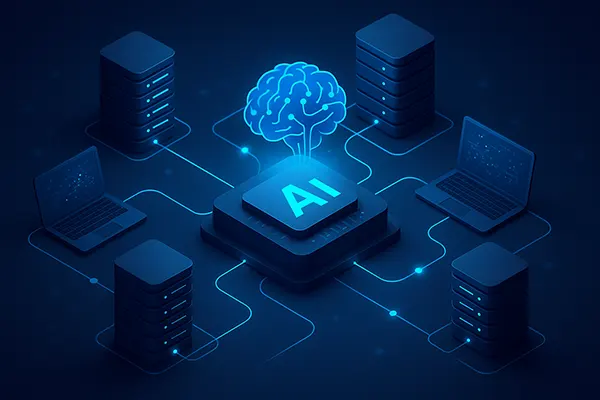Decentralised AI: Federated Learning at All Levels

Artificial intelligence is evolving beyond centralised models, moving towards structures that enhance privacy, efficiency, and resilience. Federated learning stands at the core of this transformation, enabling AI to learn collaboratively without pooling sensitive data in a single repository. In 2025, this approach is shaping industries from healthcare to finance, offering solutions that balance innovation with security and compliance.
Foundations of Federated Learning
Federated learning is a method that allows multiple devices or organisations to train a shared model while keeping data local. Instead of transferring information to central servers, only model updates are shared. This ensures that personal or proprietary data remains protected while still contributing to global AI improvements.
Its foundations rely on three core principles: decentralisation, privacy preservation, and collaborative intelligence. By distributing training processes, organisations reduce risks associated with data breaches. At the same time, decentralisation mitigates single points of failure, improving the robustness of AI systems.
Industries such as telecommunications and healthcare have been early adopters. Smartphones already apply federated learning in predictive typing, while hospitals use it for diagnostics without exposing sensitive patient records. These real-world applications show that federated learning is more than a theory; it is an established and growing practice.
Benefits Across Key Sectors
Healthcare benefits from secure training on distributed patient data, allowing models to detect diseases faster without breaching confidentiality. Financial institutions apply it to fraud detection, training models across banks without sharing customer details. For consumer technology, it improves services like voice recognition and personal assistants while protecting user privacy.
Additionally, governments and regulatory bodies view federated learning as a pathway to compliance with stringent data protection rules, such as GDPR in Europe. This regulatory alignment increases trust and drives adoption. By showing measurable improvements in efficiency and security, federated learning has become a compelling strategy for modern enterprises.
Finally, the collaborative nature of federated learning encourages cross-industry partnerships. Organisations that once hesitated to cooperate due to confidentiality concerns can now jointly build stronger AI solutions. This shared development accelerates innovation while respecting data boundaries.
Technical Challenges and Innovations
While promising, federated learning faces challenges in scalability, efficiency, and fairness. One of the main issues lies in communication overhead, as devices must frequently exchange model updates. To address this, compression techniques and optimised communication protocols are increasingly applied.
Another challenge is data heterogeneity. Devices and organisations often hold data of varying quality and structure, which can bias models. Solutions like personalised federated learning are emerging, allowing models to adapt to local conditions while maintaining a strong global baseline.
Security also remains a priority. Techniques such as differential privacy, secure aggregation, and homomorphic encryption are being refined in 2025. These methods ensure that even model updates do not leak sensitive patterns, preserving confidentiality in highly regulated fields like defence and healthcare.
Real-World Technological Progress
In telecommunications, federated learning is now embedded in 5G and 6G networks, helping to optimise bandwidth allocation and predict network failures. In finance, AI systems trained through this method achieve faster fraud detection with fewer false positives. Healthcare institutions are experimenting with multi-centre clinical trial models that use federated learning to accelerate drug development.
Tech giants and research groups are collaborating to create open-source frameworks, lowering barriers for adoption. Projects like TensorFlow Federated and PySyft are being actively updated, enabling enterprises of all sizes to explore decentralised AI. These advancements indicate that federated learning is maturing into a standard practice.
Start-ups are also playing a crucial role, developing niche solutions for cybersecurity, smart cities, and IoT ecosystems. By tailoring federated learning to specific challenges, they contribute to a diverse and competitive landscape that fuels innovation globally.

Future Outlook and Strategic Importance
Looking ahead, federated learning is expected to underpin the next generation of intelligent systems. As AI spreads to edge devices, decentralisation will be crucial for balancing performance with privacy. Federated learning ensures that smart cities, autonomous vehicles, and personal devices remain both effective and secure.
Strategically, businesses that adopt federated learning early gain a competitive advantage. They not only align with evolving regulatory frameworks but also build trust with customers who demand stronger data protection. This trust is becoming a key differentiator in the digital economy.
By 2030, federated learning could become the default approach for industries managing sensitive information. Organisations that fail to integrate decentralised AI may find themselves at a disadvantage, lacking both resilience and compliance. Thus, federated learning is not just a trend but a structural shift in AI’s development.
Long-Term Implications for Society
The societal implications extend beyond business. Decentralised AI can empower individuals, giving them greater control over their data while benefiting from collective intelligence. This balance fosters transparency and strengthens digital rights at a time when concerns over surveillance and misuse of information are rising.
In education, federated learning supports personalised learning experiences without tracking students in invasive ways. Public institutions can also collaborate globally to tackle issues like climate change, using federated approaches to share models while protecting sensitive environmental or demographic data.
Ultimately, federated learning may redefine trust in technology. By demonstrating that innovation and privacy can coexist, it strengthens the relationship between users, organisations, and AI. This cultural and ethical transformation is just as significant as the technological one.




